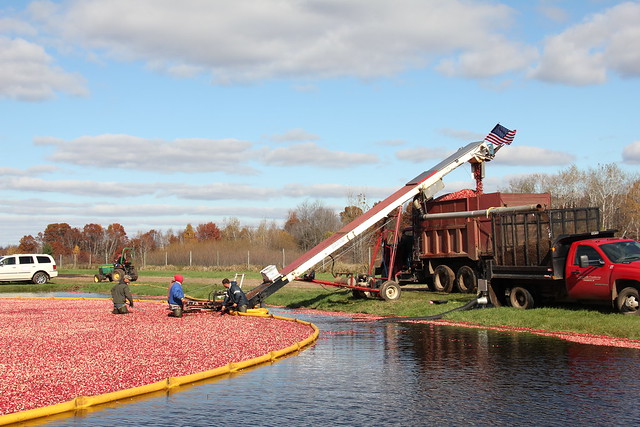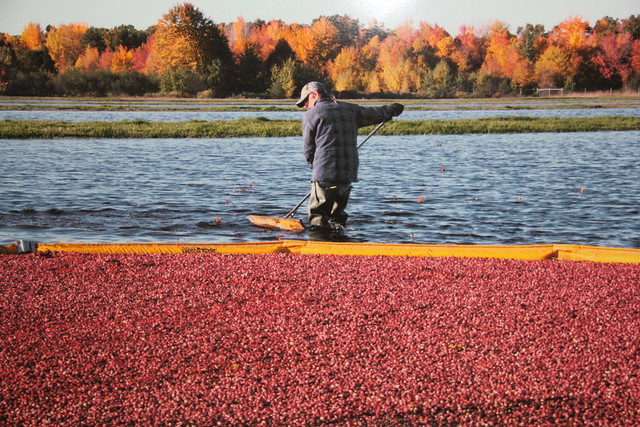
The Glacial Lake Cranberries farm, located in Cranmoor, Wisconsin, has been in Mary Brown’s family since 1923. Her 6,000 acres consists of 330 acres of cranberries, 2,600 acres of forest, and 3,000 acres of reservoirs that support the cranberry acres. Her 96 fruit beds produce 10 million pounds of fruit yearly. She runs the operation with her son, Stephen, four employees that live on the property year-round, seasonal staff, and help from family.
Cranberries have been growing there even longer, though. The farm was originally purchased in 1873 for lumber until the owners discovered an abundance of wild cranberries. “They built dikes and ditches around the native stands of vines and started cultivating the fruit,” Mary said. Wisconsin is the top state in the country for cranberries, and many producers use native vines.

Mary partnered with the USDA’s Natural Resources Conservation Service (NRCS) in 2003. “We needed renovations. It’s an old marsh and some beds planted in 1939 needed updating,” she said. “To be efficient, you need to square your beds so they are level horizontally and vertically.” Because they were built before laser levelers or modern equipment, the aging beds are uneven. “That’s been my mission — to bring everything up to the best it can be where it’s most efficient to manage,” she explained.
Through NRCS’ Environmental Quality Incentives Program (EQIP), Mary installed irrigation pipeline and sprinklers, and a complete irrigation water management system. The upgrades were tested during a frost in the spring of 2016. The results: beds with her original sprinkler systems were damaged and the upgraded beds were not.
Mary manages her forested acres with the help of NRCS’ Conservation Stewardship Program (CSP). Through conifer crop tree release, a silvicultural technique that promotes growth of individually selected species, she enhances the growth and health of her trees and improves wildlife habitat at the same time. “We’re not managing our forests for income, we’re managing our forests for natural succession and wildlife diversity,” she said. “Wildlife is abundant on my four miles of land. Every time I see a trumpeter swan or an eagle on the property — all the migrating birds stopping — it’s really inspirational for me,” she said.
Stephen and Mary realize the value of implementing a conservation plan for their property. “Conservation plans are very helpful. It’s important to plan your work and work your plan,” said Stephen. “Roy Diver, our local NRCS District Conservationist, he’s always saying, ‘Have you thought about this or that?’ He sees the bigger picture and potential opportunities. NRCS is a team effort. You guys are here to help, it’s voluntary, and we’re working together through a public-private partnership to make a good change for our natural resources,” explained Stephen.
Soil health is also a priority for Mary. “We watch the timing of our harvest so we are not compacting the soil. The harvesters can’t go in when it’s really wet; we only allow travel in certain areas when the ground is frozen.” Her employees also apply split nitrogen to reduce the risk of leaching and runoff, and to make nitrogen available during critical growth stages.
Glacial Lake Cranberries’ conservation ethic speaks for itself. “When your property has been commercially producing the same crop for 143 years, you must be mindful of conservation and sustainability,” said Mary.

She realizes her marsh is part of a bigger conservation picture. “I feel responsible for the land. I’m not just a cranberry grower, I realize I’m responsible for wetlands, forests, and hiking and hunting areas. All this needs to work together. When we conserve, it’s about moderating everything you do. It all comes together to define conservation,” she said.
“This property is self-motivating. When you live here, work here, and own it, you feel very responsible for taking care of the land. Whether it’s the sunsets, sunrises, northern lights, the birds migrating through, or the harvest that’s coming in, there are so many rewarding and motivating things we’ve been blessed with, and the partnership with NRCS has been a great part of that,” said Mary.
To learn more about how NRCS can help you with conservation on your land, visit www.nrcs.usda.gov.

